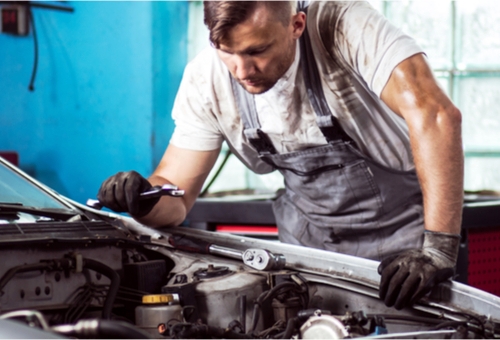
Here is a question to ponder as 2020 starts: do you think you contribute to the workshop you work at in terms of customer satisfaction, or do you consider yourself to be primarily a technician and therefore leave customer service to management and the front office staff? Many technicians, and especially those that are newly qualified or seldom interact with customers directly might see this question as trivial and even spurious, but if the truth were told, most of us could benefit from revisiting the role we as technicians play in how our customers experience their interactions with us and our places of employment.
Therefore, in this article, we will explore our roles as customer service representatives, but note that while this article is primarily aimed at newly qualified technicians, it is not the intention of this article to discourage young technicians from using initiative, resourcefulness, and their critical thinking skills to resolve customer concerns. The opposite is, in fact, true; the purpose of this article is to encourage young technicians to use their skills, knowledge, and problem-solving abilities to their maximum extent because this is what ultimately results in successful repairs and happy customers, but-

We should care because we have pride in ourselves, our work, our knowledge, our skills, and how we can use our knowledge and skills to resolve the often very tricky problems that come with modern automotive diagnostics and repair. It hardly matters whether we work for a prestigious dealership, for a large national chain, or a small two-hoist, three-bay family owned business, the basic premise is always the same, which is to always do the right thing.
While “doing the right thing” is second nature to many experienced technicians because both their livelihoods and professional reputations depend on it, it is often very easy for newly qualified mechanics and technicians to forget the first rule of car repair, which simply states, Do No Harm. We are of course not suggesting that newly qualified mechanics and technicians with limited experience can or will deliberately cause damage and/or harm to customers’ vehicles, far from it. But then again, we all understand the realities and practical difficulties a new mechanic working under severe time constraints faces, and especially while focusing intently on getting through his day without making serious mistakes or falling behind schedule.
Thus, given that today’s professional environment can be extremely demanding and competitive, newly qualified technicians might be forgiven for relegating customer service/satisfaction to the proverbial back burner. However, and while this might come across as preaching to the converted, the fact is that for many customers, their cars are the second biggest financial investment they will ever make after buying their homes and therefore, failing to always place the customer's interests first is the quickest way to lose that customers' business.
Essentially, all of the above comes down to always doing the right thing by the customer, which is not (always) as difficult to do as you might think. Nonetheless, there is something else to consider, and that is how best to serve the interests of our employers, or more to the point, the interests of the entire car repair industry as a whole without making customers feel that they were cheated somehow.
Unfortunately, it must be said that customers are left with the short end of the stick more frequently than some of us would like to believe. Moreover, it happens more frequently than the car repair industry can afford since an unhappy customer's bad experience with a workshop will usually result in that workshop also losing some (or all) of the unhappy customer's family, friends, colleagues, and acquaintances. Given that some, or all of an unhappy customer’s family, friends, colleagues, and acquaintances may have been regular customers at the same workshop for many years, the question now becomes-

This writer does not pretend to have the answer(s) to every customer service concern that might arise, but having worked on both sides of the fence, so to speak, his experience(s) as a technician on the workshop floor and later as a workshop owner/manager might be of some value /benefit to some readers. Here is what this writer has learned over the years-
Even if the establishment you work at offers free vehicle inspections as a part of every job you do, there are still two very different ways to approach a vehicle inspection. The first form of vehicle inspection involves finding things and/or services to up-sell to the customer to increase the value of all work orders, and in this type of inspection, the overall condition of the car is very often of secondary importance.
The second type of inspection, which this writer prefers, involves focusing primarily on the overall condition of the car, but with special emphasis on the condition and operation of safety critical systems, parts, and components. There is one overriding guiding principle involved with this type of inspection, which is ensuring that the vehicle is in the best/safest possible condition that it can be in when it leaves the premises. With this principle in mind, you will not miss something like a corroded/damaged/leaking brake line, since your inspection is intended to find exactly this kind of problem.
It is pointless to argue about which is the more important- your potential liability, or the customers' safety because the point is that by performing proper, targeted inspections you can both ensure the customer’s safety, and find things/services to up-sell. However, with a targeted inspection, the things/services you find to up-sell will usually have real, tangible benefits to the customer while increasing the value of the work order at the same time, which typically keeps both employers and customers happy.

Exhorting technicians to “fix something right the first time” should in this writer’s opinion not be required since the need to fix something properly is self-evident, and should therefore not have to be included in an article about car repair and customer service/satisfaction.
However, there are exceptions to every rule, and in this instance, the exception was a young technician of this writer’s acquaintance who refused to take direction on anything. His refusal to accept advice or direction while struggling with an abstruse diagnostic problem would have been perfectly justified had he known everything as he so often claimed, but unlike most rational people, this young technician also refused to accept that he did not know what he did not know.
The fact that this young technician left the car repair industry less than two years after starting his career as a technician to inflict himself on the fast-food industry is somewhat irrelevant, but there is nevertheless a moral to this story, and it is this: bad attitudes create unhappy customers.
Some might argue that new automotive technologies are being adopted so often that it is nearly impossible to keep abreast of new advances. While this is true, it is also true that a), the technical details of new technologies are very often published (almost) as soon as they are implemented in new models, and b), technicians in other parts of the country/world have figured out diagnostic strategies that address issues with new technologies by the time you run into an issue. Thus, the argument that we do not always have access to dealership-level technical/service information is not always valid, even if the information comes at the price of a subscription.
We need not recount a list of the incidents perpetrated by the know-it-all young technician that has caused customers to take their business elsewhere here. Suffice it to say though that he once caused a catalytic converter failure because he did not know that some catalytic converter trouble codes will not set while for instance, some oxygen sensor codes are present- which is what the customer was complaining about.
The above example represents a huge gap in the young technician’s basic knowledge, and although opportunities for formal training in new technologies are relatively scarce in Australia, there are many online resources available (mechanic.com.au, Identifix, and iATN immediately come to mind) that will soon reveal what it is we/you don’t know. Therefore, since knowledge is power, we can all use these and other resources to avoid creating unhappy customers.

Customers typically have several expectations when they hand us their vehicles, and this writer can recount many tales of technicians of his acquaintance failing to either meet or manage customers’ expectations, which is the surest way to lose a customer.
Employers also have certain expectations of the technicians in their service, and it is where these two sets of expectations intersect each other that issues sometimes arise because young, inexperienced technicians may not always realise exactly where or when the two sets of expectations intersect. Put in another way, the fact is that workshops are not judged by customers on their neat and/or high tech reception areas or the free coffee they are served there; workshops are judged mainly by how well, or otherwise, their expectations have been met in terms of the quality of the repair(s) they are paying for.
So if you are just starting your career, you may be wondering how to meet (and preferably, exceed) the expectations of both your employer and your customer. In practice, the best way to approach this apparent conundrum is to realise that the two sets of expectations are neither mutually exclusive nor in competition with each other.
Put simply, your employer needs you to resolve the customer's concern(s) definitively, while your customer expects to receive his repaired vehicle back in a reasonable time. Your employer's expectations may not always be easy to meet, but the customer's expectations are seldom difficult to meet.
Simply treat his vehicle with respect; in fact, treat it as if it were your own, regardless of whether it is an entry-level city runabout, or a hyper-expensive, top-of-the-line luxury vehicle. Look at it from the customer’ point of view, and don’t leave grease prints over the bodywork, seats, carpets, and steering wheel, or lose the presets in his audio/entertainment/ navigation system(s), or the presets in his seat(s), steering wheel position, or side mirrors. Having fixed a difficult issue means nothing if, like the mechanic in the above picture, you hand a customer his vehicle back in a worse state than it was in when you received it. You would not like it if it happened to you and your vehicle, so why should a customer like it?
One more thing though- if you cannot verify a repair because, for example, additional tests and/or monitors need to run and complete before you can verify the repair or turn off warning lights, tell both your employer and the customer about it. The customer will then know what to expect of the repair and the possible need for a return visit, and your employer won't be caught unawares when the very irate customer returns two days later with a "comeback" that he did not know to expect.
The dictum, “Do No Harm” is as true and valid for car repair professionals as it is true for medical professionals. Unlike most medical professionals, however, many automotive technicians are not always sure what exactly constitutes the notion of “harm”. We are not talking about obvious forms of harm like starting an engine without oil in the crankcase, or doing a series of burnouts with a customer’s vehicle to test its throttle response- we are talking of forms of harm that may not always be easy to quantify, determine, or even identify.
One of the biggest problems new technicians face is the fact that they do not always fully realise the full extent of the differences between how most customers and most technicians see the same problem or set of circumstances. There are too many examples of this to list all or even most of them here, but let us look at two common situations-
Cost savings: Part 1
You may sometimes think that you are trying to save the customer some money by not doing something that may be required, such as not resetting the alternator/charging system after a battery replacement.
The customer may derive some financial benefit in the short term by paying a smaller repair bill, but in the medium to long term, that customer may be out several hundred dollars when the new battery fails prematurely. When that happens, the customer will have forgotten about the few dollars you had saved him, or worse, he may not even have known that the required reset was not performed. All the customer will be interested in at that point is the fact that his new battery had failed unexpectedly, and he will want a replacement.
This writer had seen lawsuits filed on similar grounds, and while he is not suggesting that you might be sued on any given day of the week, he is suggesting that trying to save customers money on repairs is a bad idea, and especially so if the customer did not ask for it. If you have ever felt like taking legal action against a service provider, you will understand how the customer with the failed battery might feel when he decides to take his business elsewhere- even if he does not sue you and/or your employer.
Cost savings: Part 2
In this scenario, the roles are reversed. The customer wants to save money so he asks the service writer to make a note on his work order stating that only the bare minimum must be done to get his vehicle running again.
Experienced technicians have seen this many times, and one would have thought that experienced service writers would not accept such instructions from customers. Then again, most service writers are not technicians, so they could perhaps be forgiven for not realising that accepting such instructions often makes life very difficult for a technician. Nonetheless, the fact is that not doing everything that is required to resolve a customer's concern definitively, such as fitting new brake pads but failing to replace the severely worn brake rotors, could be seen as a form of harm being done.
There are many other possible examples, but the truth is that very few if any technicians have the power to refuse to undertake work of this nature. Therefore, the only thing to do in such cases is to inform the customer and your employer that the "repair" does not resolve the customer's bad brakes, or whatever the case may be, and that more work is required to complete the repair to professional standards.
Informing the customer in writing that additional work is required is not only the right thing to do. It is also the only thing you can do to limit your liability should the vehicle be involved in an accident caused by the vehicles’ poor brakes- or some other problem you were not allowed to repair to professional standards, which leaves us with this-
The path we travel as professional technicians is not always an easy one, but with some forethought, planning, and a professional or mindful attitude it is possible to do the right thing by both our customers and our employers, even if the right thing is not always easy to do- or to recognise as the right thing.
However, we have the responsibility to both inform our customers of defects, problems, and faults on their vehicles, even if they elect not to have those defects, problems, and faults corrected. What customers decide to do with the information we give them is none of our collective concern, but we have the collective and individual responsibility of informing them, nevertheless.